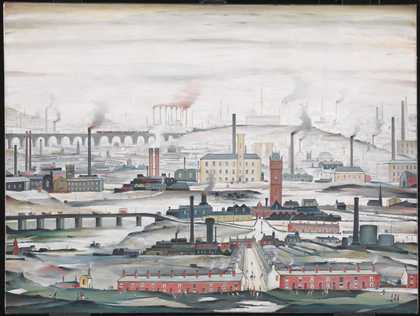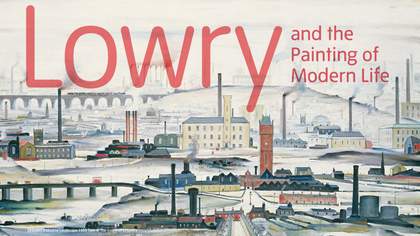
L.S. Lowry
Industrial Landscape (1955)
Tate
Tate Britain, Level 2 Gallery
26 June – 20 October 2013 (press view: 24 June 2013)
Open daily 10.00 – 18.00
For public information number please print 020 7887 8888
This summer Tate Britain will present a major exhibition of urban landscapes by the much loved British painter L.S. Lowry (1887–1976). This is the first such show held by a public institution in London since the artist’s death. It results from an invitation extended to the distinguished art historians T.J. Clark and Anne M. Wagner to reappraise Lowry for a new and extended audience. This exhibition takes its title from T.J. Clark’s seminal book, The Painting of Modern Life: Paris in the Art of Manet and His Followers (1985).
Bringing together around eighty works by Lowry, including Tate’s own pictures Coming Out of School 1927 and The Pond 1950, alongside significant loans, the show aims to re-assess Lowry’s contribution as part of a wider art history and to argue for his achievement as Britain’s pre-eminent painter of the industrial city.
What was the nature of that achievement? Although Lowry’s most frequent subjects were drawn from a pattern of streets he tramped daily for a living – he worked for most of his life as a rent collector – his is not straightforwardly a ‘realist’ art. Nor is it ‘impressionist’, though there are few 20th-century British artists, the show will argue, who engaged more fruitfully with the French tradition. If Lowry, as one critic put it, did not ‘serve up the latest … from abroad’, he was all the more able to reach back to where the 19th-century ‘painters of modern life’ had left off.
The show aims to reveal what Lowry learned from the strange ‘symbolist’ townscapes of his French-born teacher at the Manchester School of Art, Adolphe Valette, and demonstrate important parallels with late 19th and early 20th century French painting, including eleven works by Vincent van Gogh, Camille Pissarro, Georges Seurat, Adolphe Valette and Maurice Utrillo. What resulted from Lowry’s special apprenticeship as an artist – provincial and proud of it, still with a sense of Cottonopolis’s great place in history – was a laconically descriptive way of painting that aimed to convey the structural logic of the city.
For Lowry modern painting needed a mode of observation capable of representing the remaining rituals of public life: football matches and protest marches, evictions and fist-fights, workers going to and from the mill. Without his pictures, Britain would arguably lack an account in paint of the experiences of the 20th-century working class.
Above all, Lowry was a landscape painter and wished to show what the industrial revolution had made of the world. Lowry and the Painting of Modern Life will bring together the artist’s late urban panoramas, where a leap up to ‘history painting’ size indicates the measure of his final ambition. The big landscapes fall into two groups: the first, from the 1950s, are titled, with intentional generality, Industrial Landscapes. The second – less well known – was painted in the 1960s in the mining valleys of South Wales, heartland of the Labour movement. In both the tone is valedictory.
L.S. Lowry was born in Stretford, Lancashire. Many of his works depict nearby Salford and surrounding areas including Pendlebury, where he lived and worked for over 40 years. On leaving school in 1904, he began work in Manchester as a clerk with a firm of chartered accountants, studying painting and drawing in the evenings at the Municipal College of Art (1905–15), and at Salford School of Art (1915–25). In 1916, he joined the Pall Mall Property Company as a rent collector, and remained there until he retired with a full pension in 1952. Lowry’s reputation was slow to be established, it was not until 1930s that he achieved recognition for his work, later being invited to become an official war artist and then in 1962 a Royal Academician.
The exhibition is curated by T.J. Clark and Anne Wagner, emeritus professors of art history at the University of California, working with Helen Little, Assistant Curator, Tate Britain.

